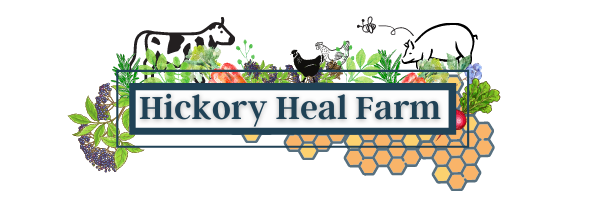How Low-Tillage Practices Boost Soil Health and Benefit Soil Microbes
At Hickory Heal Farm, we believe that healthy soil is the foundation of a thriving farm. Our approach to regenerative farming focuses on long-term soil health, and one of the key practices we’ve adopted to achieve this is minimum tillage farming. Traditional tillage techniques are widely used in conventional farming. However, we’ve found that reducing tillage not only benefits the environment but also plays a critical role in enhancing soil microbial life. The shift is essential for a thriving farm ecosystem.
In this blog post, we’ll explain why minimum tillage farming is so beneficial to soil microbes and why we are working to embraced this regenerative practice.
What is Minimum-Tillage Farming?
Tillage refers to the process of turning, mixing, or breaking up the soil using tools such as plows, harrows, or disks. While tillage can help break up soil for planting, it often comes at a cost: it disrupts soil structure, reduces organic matter, and harms beneficial soil organisms.
Minimum tillage, on the other hand, involves minimizing or eliminating mechanical soil disturbance. Instead of plowing or turning the soil, we use alternative methods like no-till drills, cover crops, and careful crop rotation to plant seeds without significantly disturbing the soil’s structure. This approach allows us to keep the soil intact, providing a healthier environment for the living organisms that thrive beneath the surface.
How Minimum-Tillage Farming Helps Soil Microbes
Soil is alive! Beneath the surface, a complex and diverse community of soil organisms, including bacteria, fungi, earthworms, and protozoa, work together to break down organic matter, cycle nutrients, and keep the soil healthy. These microbes are vital for maintaining soil fertility, enhancing plant health, and supporting the entire farm ecosystem.
However, tillage disrupts these delicate microbial communities. The process of tilling can destroy soil structure, expose microbes to harsh conditions, and disturb their natural habitats. By practicing minimum-tillage, we allow the soil microbiome to thrive, benefiting both the soil and our crops.
Here are just a few ways low-tillage helps soil microbes:
1. Preserves Soil Structure and Habitat
When soil is tilled, it becomes more vulnerable to erosion, compaction, and the loss of organic matter. Low-tillage helps preserve the natural structure of the soil, creating stable micro-habitats for soil organisms. Healthy soil aggregates, or clumps of soil particles bound together by organic matter, provide niches for beneficial bacteria and fungi to thrive.
2. Protects Soil Microbes from Disturbance
Tilling can damage microbial colonies that play a vital role in breaking down organic matter, fixing nitrogen, and enhancing plant nutrient uptake. By minimizing disturbance, we protect these communities and enable them to continue their work of feeding plants and improving soil health.
3. Encourages a Diverse Microbial Community
Healthy, diverse microbial communities are crucial for nutrient cycling, disease suppression, and overall soil fertility. With minimum-tillage practices, we support an ecosystem that allows a broad range of microbes to thrive, from nitrogen-fixing bacteria to decomposers like fungi and earthworms. This diversity helps the soil remain resilient to environmental stresses and promotes better plant growth.
4. Improves Organic Matter and Carbon Sequestration
Tillage accelerates the decomposition of organic matter by exposing it to air, which can result in the loss of valuable carbon in the form of CO2. In contrast, minimum-tillage farming allows more organic matter to remain in the soil, providing a steady food source for soil microbes. Over time, this practice helps increase the amount of organic carbon stored in the soil, contributing to improved soil fertility and enhanced carbon sequestration.
Benefits Beyond Soil Microbes
While low-tillage farming is excellent for soil microbes, its benefits extend to the entire farm system. By reducing soil disturbance, we experience a range of positive outcomes:
- Improved Soil Structure: Over time, soil structure improves as low-tillage practices promote aggregation, water infiltration, and aeration, resulting in less erosion and better root growth.
- Enhanced Water Retention: Healthy soil with intact structure holds moisture better, reducing the need for irrigation and supporting crops during dry spells.
- Reduced Fuel and Labor Costs: Low-tillage methods require less heavy machinery, saving on fuel costs, reducing labor time, and decreasing the carbon footprint of farming activities.
- Greater Biodiversity: A diverse microbial community supports plant diversity, which, in turn, enhances the overall biodiversity of the farm.
Conclusion
At Hickory Heal Farm, we are committed and shifting to using sustainable, regenerative farming practices that promote the health of our land, crops, and community. Minimum-tillage is one of the most effective ways we can support soil microbes, reduce soil erosion, and enhance soil fertility over the long term.
By reducing tillage, we not only help soil organisms thrive but also create a more resilient farm ecosystem that benefits both the environment and our crops. If you’re looking to improve your soil health, consider incorporating minimum-tillage techniques into your farming practices, you’ll be amazed at the difference it can make for your land, your plants, and the future of farming.
We have found in the raised beds it is easy to implement the minimum tillage methods. We have seen the wonderful benefits of no tillage. In the row crop garden, soil amendments are essential to transition to the no till method, as our soil is clay and sand. The ground at best is hard and difficult to irrigate. We will continue to till in this area until we build the topsoil above the current ground level.
I will revisit this topic with how to transition to no till.










